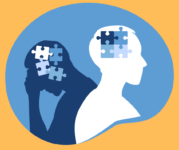The History of Dissociation
The history of dissociation dates back to the early days of psychology. In the 19th century, experts began to observe moments when some individuals felt detached from their thoughts, emotions, and experiences. These observations led to the development of the concept of dissociation. It quickly became evident that dissociation was often associated with traumatic experiences, serving as a way for the mind to respond to overwhelming situations. As time passed, the understanding of dissociation grew and became linked to various psychological disorders.
Dissociation is often regarded as a survival mechanism of the mind. In situations of extreme stress, anxiety, or trauma, the mind can separate itself from the full experience to protect the individual from overwhelming emotions. This temporary “shutdown” of consciousness can occur as a way to prevent someone from fully experiencing the impact of a traumatic event.
Understanding the relationship between dissociation and trauma has led to greater insight into how people cope with severe situations. This understanding has, in turn, contributed to the development of approaches and techniques to assist individuals struggling with dissociative symptoms. Therapists have benefited from this knowledge to offer more effective methods of treatment and support to those facing these challenges.
Over the years, the understanding of dissociation has deepened through ongoing research and observation in the psychological community. What was once a mysterious phenomenon is now better understood, particularly in relation to how it can arise as a response to various circumstances, including trauma and stress.
Today, the treatment of dissociation often involves therapies focused on recognizing triggers, building resilience, and gradually exploring traumatic experiences to enable healing and integration. The understanding of dissociation has genuinely contributed to the creation of a safe and supportive environment where individuals can work towards restoring their emotional well-being.
Through the years, we have not only learned about dissociation but also about each other. We have come further from where we began and this ongoing process of understanding and growth will help us create a world that is more inclusive, empathetic and supportive for everyone.
Symptoms of a Dissociative Disorder: A Deeper Dive
Dissociative disorders encompass a range of symptoms reflecting a sense of disconnection from one’s identity and surroundings:
Feeling disconnected from yourself and the world around you
This feeling of alienation can range from a subtle absence to an intense sense of not truly being present in the current moment.
Forgetting about certain time periods, events and personal information:
Dissociative amnesia can occur, where parts of memory become inaccessible as a protective mechanism against traumatic experiences.
Uncertainty about who you are: This can occur when someone experiences different aspects of themselves as separate “parts,” stemming from attempts to avoid trauma.
Having multiple distinct identities: This characteristic emerges in Dissociative Identity Disorder (DID), formerly known as ‘Multiple Personality Disorder.’ People with DID can have different personalities that manifest at different times.
Understanding these symptoms provides insight into the complexity of dissociative disorders and how they manifest in people’s everyday lives. As professionals and supportive individuals, adopting an empathetic approach is crucial, where understanding, support, and patience can be key in helping those grappling with these challenges.

What Happens When You Experience Dissociation?
Dissociation often appears as a temporary feeling of detachment. When you experience dissociation, you may feel mentally disconnected from your body, as if you are an observer of your own experience. Some individuals also report that the world around them seems unreal or altered.
In milder dissociation, you might notice yourself drifting momentarily in thought as if you’re not fully present. Perhaps you’ve experienced reading a book or watching a movie, getting absorbed in the story and momentarily forgetting your surroundings.
In more intense dissociation, it can feel like you’re watching yourself from a distance, like a spectator observing your own life. This can create a strange sense of detachment as if you’re temporarily detached from your own body and emotions. Imagine looking through a window at yourself, going about your daily tasks, without truly feeling physically present.
Some individuals experiencing dissociation might also perceive the world around them as unreal or muted. Colours may seem dimmer, sounds might appear muffled, and everyday objects could lose their typical significance. This sense of alienation can feel unsettling or confusing, particularly when it occurs unexpectedly.
It’s important to understand that dissociation is the brain’s response to stress, anxiety, or trauma. While it can be uncomfortable at times, it often serves as a survival mechanism that allows us to “escape” emotionally overwhelming situations. If you find yourself having dissociative experiences, speaking to a professional can help you comprehend the causes and potential coping strategies.
In summary, dissociation can range from mild absent-mindedness to profound detachment. Understanding these experiences is a crucial step in supporting individuals dealing with dissociation and normalizing conversations about mental health.
The Body’s Connection: How Dissociation Manifests
Understanding dissociation goes beyond the mind; it extends to the body’s intricate responses. Dissociation isn’t limited to mental experiences; it also finds expression in physical sensations and reactions. Here’s how dissociation can manifest in the body:
Somatic Experiences: Dissociation often intertwines with somatic experiences, where emotional distress can lead to physical symptoms. These might include unexplained pains, tension or discomfort. It’s as if the body echoes the emotions that the mind struggles to process, translating them into physical sensations.
Numbness and Tingling: Some individuals report feelings of numbness or tingling in their extremities, almost as if parts of their body are “falling asleep.” This sensation can mirror the emotional detachment that comes with dissociation, where the connection to one’s own body feels distant.
Detachment from Sensations: During dissociation, you might feel disconnected from the sensations of touch, temperature or even pain. It’s as if the body’s ability to perceive stimuli is altered, creating a buffer between you and your physical surroundings.
Out-of-Body Sensations: Individuals experiencing dissociation can feel like they’re outside their bodies, observing themselves from a distance. This detachment can lead to sensations of being disconnected from the physical vessel that is the body, intensifying the sense of being an observer rather than a participant in one’s own life.
Body Memory: Traumatic experiences can become imprinted in the body’s memory, resulting in physical responses triggered by certain cues. Even if the mind doesn’t consciously recall the trauma, the body reacts to reminders, causing physiological changes like increased heart rate, rapid breathing or muscle tension.
Reconnecting the Mind and Body: Recognizing how dissociation affects the body is crucial for holistic healing. Integrative therapies that acknowledge both the mind and body, such as mindfulness practices, trauma-sensitive yoga (TCTSY) and breathwork, can help bridge the gap between the two. These approaches allow individuals to reconnect with their bodies and use them as a resource for grounding and healing.
Understanding how dissociation intertwines with bodily experiences adds depth to our comprehension of this phenomenon. By acknowledging the body’s role in dissociation, we can offer more comprehensive support to those navigating the complexities of dissociative experiences. This knowledge empowers us to foster a sense of unity between mind and body, paving the way for a more harmonious journey towards healing and self-discovery.
The Different Stages of Dissociation: What You Should Know
Dissociation is like a puzzle with various pieces. Our thoughts, memories and feelings can sometimes get a bit jumbled. There are four major ways this can happen:
Dissociative Amnesia (Memory Loss): Sometimes, we can’t remember parts of our memories. It’s like a piece of our memory goes missing for a while. This can happen as a sort of protection when things have happened that we can’t process.
Dissociative Fugue (Lost Time): Imagine suddenly waking up somewhere and not knowing how you got there. This is called a ‘fugue.’ It’s like you’ve lost yourself for a while and ended up in a different place.
Dissociative Identity Disorder (More Than One You): Sometimes, it feels like there are different parts of yourself. You can feel like different people at different times. It’s like there are multiple ‘you’ inside you, and they can feel very different.
Depersonalization Disorder (Feeling Detached from Yourself): Have you ever had that feeling when you’re in a dream and everything seems a bit fuzzy? Sometimes, this can happen as if you’re not really connected to your own body or the world around you. It all seems a bit strange.
Is Dissociation Similar to ‘Daydreaming’?
Imagine you’re sitting in class, the teacher is talking, but suddenly you start daydreaming. That means you drift away into your thoughts and aren’t really paying attention. This is a bit like what dissociation can be.
Dissociation is like a kind of daydreaming, but sometimes, it feels stronger. It’s as if you’re disconnecting from what’s happening around you. You can get lost in your thoughts and it can seem like you’re not really here.
So, yes, dissociation is a bit like ‘daydreaming.’ It’s a way your mind takes a little break from what’s going on. It can be mild, like daydreaming, or it can be more robust, making you feel like you’ve lost yourself a bit.
If this happens and makes you uncomfortable, talking to someone you trust can help. They can help you understand why it’s happening and how to deal with it. Remember, you’re not alone, and there are ways to cope if you want to.
A Journey of Understanding and Hope: Connecting Past to Present
In our quest to comprehend the puzzle of dissociation, we’ve taken significant strides, embarking on a journey from the past to the present. From the days when this phenomenon was shrouded in mystery to the contemporary understanding that enables us to create compassionate spaces for those struggling.
Dissociation once deemed the veil of the unknown, is now illuminated by the spotlights of scientific discovery and human empathy. What began as a dark cloud of misunderstanding has given way to a horizon of hope and healing.
Each step we’ve taken in understanding the various forms of dissociation, from moments of daydreaming to the deeper experiences of detachment, has brought us closer together. As a community, we’re committed to welcoming, supporting, and learning from one another with open arms.
And as we continue our journey of understanding, we embrace history as our guide. We acknowledge the suffering and resilience of those who came before us and we carry forward their work through our own contributions to a more inclusive, empathetic and loving world.
Let’s persist in spreading awareness, sharing stories, and cultivating a culture where mental health no longer resides in the shadows. Let us illuminate the path with understanding, compassion and an unwavering dedication to building a world where no one feels alone.
Our journey is one of connection, one of transformation and one of hope. Together, we traverse this path, fueled by the warmth of the past and guided by the promise of a compassionate future.
With care
Esther

Leave A Comment